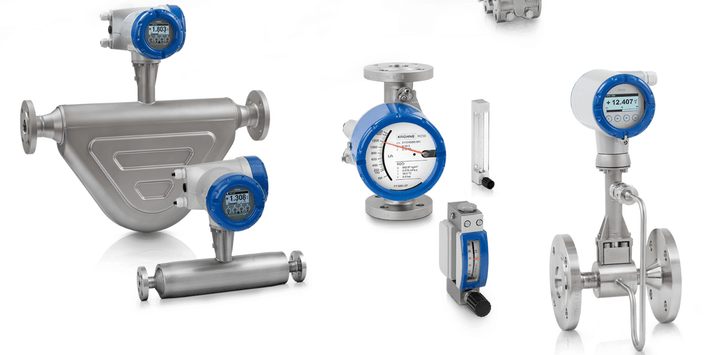Various flow meters work in enhancing system's efficiency, accuracy and even reliability lasting in long-term. It's essential to look into nuances of each type and how they are solving critical industrial needs. Find a type of flow meter to cater to specific needs.
Types of Flow Meters
Mass flow meter
A mass flow meter, aka an inertial flow meter, is used to measures mass flow rate of a fluid flowing through a tube. The mass of the fluid flowing past the fixed point per unit time is called the mass flow rate. The mass flow meter measures the mass rather than the volume per unit time (e.g. kgs per second) sending through the device.
Coriolis flow meters are taken as the most accurate flow meters repeatable at present. They send fluid in vibrating tubes and monitor changes in the fluid's momentum. Fluids through vibrating tubes cause slight twist or deform. Such twists and deforms are directly proportional to mass flow rates. Coriolis meters perform in both mass and density measurement, being versatile in various applications like chemicals, oil, and gas industries. Their outstanding performances in precision and widespread use are primary reasons for their popularity in complex industrial systems.
Obstruction Type
Differential Pressure (DP) flow meters have been refined for evolution in modern industry needs, remaining the most reliable option in flow monitoring and measurement. The pressure difference are measured on the basis of the principle that a certain relationship between the pressure difference generated when the fluid flows through the throttling devices and the flow rates. The throttling device is a local contraction element installed in the pipeline. The most commonly used ones are orifice plates, nozzles and venturi tubes, being widely used in industrial process measurement and control.
A variable area meter works through measuring the fluid flow crossing the sectional area of the device to vary in response to the flow. Some measurable effect indicates the rate. A rotameter, an example of variable area meter, are available for wide ranges of liquids and are commonly used with water or air. Another example is a variable area orifice, in which the fluid flow sending through an orifice will deflect a spring-loaded tapered plunger.

Request a Free QuoteInferential Flowmeter
The turbine flowmeter transforms the mechanical action to a user-readable rate of flow. like gpm, lpm, etc. The turbine wheel is set in the path of a fluid stream so that all the flow travelling around it. Then the flowing fluid impinges on the turbine blades, producing a force onto the blade and pushing the rotor in motion. The speed of the turbine is proportional to fluid velocity when a stable rotation speed reaches.
Electromagnetic Flowmeter
The magnetic flowmeter, also known as "mag meter" or "electromag", use a megnetic field applied to the metering tube, which causes a potential difference in propotion to flow velocity perpendicular to the flux lines. Such meters work on Faraday's Law of Electromagnetic Induction, in which a magnetic field is applied to the fluid. Then the flow rate could be determined by the measured resulting voltage. The go-to solution for industries involving dirty, corrosive or abrasive fluids. For purposes of precision and durability, magnetic flow meters are often applied in water treatment, chemical processing, as well as food and beverage manufacturing.
An ultrasonic flow meter measures velocity of fluids by ultrasound to calculate volume flow. The flow meter is able to measure the average velocity along the path of an emitted beam of ultrasound via ultrasonic transduces. Calculate the difference in transit time between pulses of ultrasound down into or against the direction of flow or measure the frequency shift relying on the Doppler Effect. In addition to acoustic property of the fluid, temperature, density, viscosity and suspended particulates are also factors impacting an ultra flow meter.
A vortex flow meter operates on the principle "von Kármán vortex", monitoring fluid flow rate by measuring frequency of vortices. In general, the frequency of vortices is directly proportional to the flow rate. The piezoelectric element in the detector generates an alternating charge signal with the same frequency as the vortex. Then such a signal is delivered to the intelligent flow totalizer for further processing.
Mechanical flowmeters
A positive displacement meter measures the volume of fluids flowing through a vessel like a bucket or a stopwatch. The flow rate could be calculated by the ratio of volume and time. Filling and emptying buckets continuously is needed for the purpose of continuous measurement. Piston meters, oval gear meters and nutating disk meter are all examples of positive displacement meters.
From versatile mechanical flowmeters to highly precise Coriolis and ultrasonic meters, each type is tailored to meet specific industrial needs. Whether you need to handle gases, liquids, or steam, there’s a solution for you. Take the next step toward improving your system's efficiency by reaching out for expert guidance. Contact us today for a free, no-obligation quote, and let us help you find the perfect flow meter for your operation!
Media Contact
Company Name: SHENZHEN LONNMETER GROUP
Email: Send Email
Country: China
Website: https://www.lonnmeter.com/

